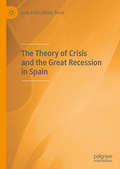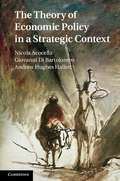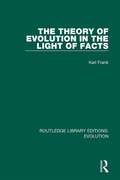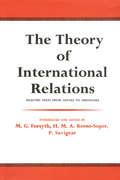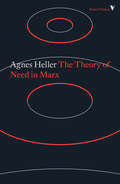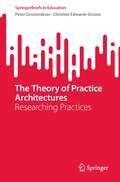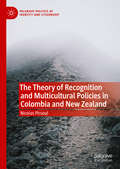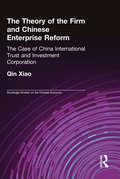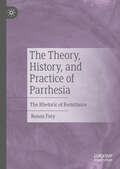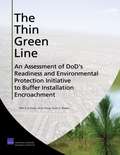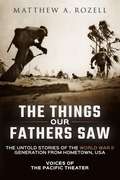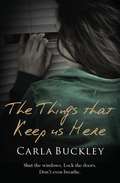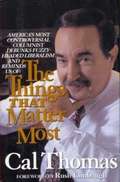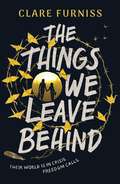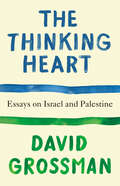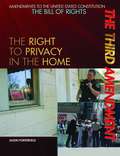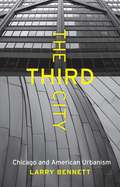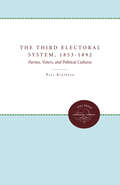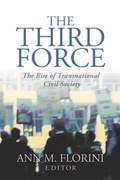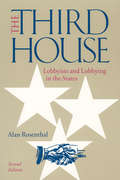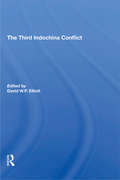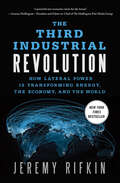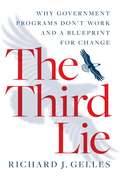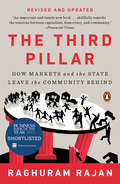- Table View
- List View
The Theory of Crisis and the Great Recession in Spain
by Juan Pablo Mateo ToméThis book has a dual purpose. First, it analyses the concept of economic crises within economic theory, showing the various theoretical foundations and controversies amongst different schools of economic thought. Second, it presents an empirical analysis of the Great Recession in Spain, addressing the growth period of 1995 to 2007-08, the subsequent depression until 2013-14 and the recovery that followed. It also shows the way in which the inner contradictions of capital manifests itself in an European peripheral economy under a real estate bubble, emphasizing the role of the Spanish economy in European capitalism.This theoretical and empirical heterodox approach will be of interest to students and scholars in political economy, and those with an interest in the Eurozone.
The Theory of Economic Policy in a Strategic Context
by Giovanni Di Bartolomeo Nicola Acocella Andrew Hughes HallettIn developing a new and highly innovative theory of economic policy, this book deals with conflicts between strategic actions by public and private agents. It builds on the Lucas critique but also applies the tools introduced by Tinbergen and Theil to dynamic policy games and from there derives a new theory of economic policy. Its main propositions describe such properties in the models currently used for policy-making as neutrality and equilibrium existence, uniqueness, and multiplicity. These properties are key to understanding the impact of concepts such as rational expectations, time inconsistency, communication and the use of policy announcements. As the numerous examples show, they are useful both for model building and for devising optimal institutions. The Theory of Economic Policy in a Strategic Context is an essential but accessible tool for economic researchers involved in policy questions.
The Theory of Evolution in the Light of Facts (Routledge Library Editions: Evolution #3)
by Charles T. DrueryOriginally published in 1913, The Theory of Evolution in the Light of Facts examines the theory of Descent; the book is a time capsule of information, providing a record of the explorations into Darwinian theory during the first half of the 20th century. The book examines the contradictions which arose between technical work of the period and the assumptions surrounding the theory of evolution. The book aims to address that which is considered ‘certain’ or ‘probable’ from postulation in order to explain and clearly define the theory of evolution. It does this through hypothesising on the development of animals and plants using the systems of Darwin and Lamarck. This book will be of interest to anthropologists and historians of natural science alike.
The Theory of International Relations: Selected Texts from Gentili to Treitschke
by Friedrich LutzThe great writings of the past on the subject of international relations add an important dimension to the contemporary study of the field. The Theory of International Relations consists of substantial selections from authors whose ideas should be readily available to all students of international relations. All the passages selected by the editors ask fundamental, theoretical questions searching for the essence of interstate relations. This quest for answers carries the reader into investigations of the causes of war, the balance of power, the relationship between international relations and the political theory of the state, and other major issues of this subject.The editors provide an introduction to the work, which sets out the principles of selection and their belief in the relevance of political thought to the understanding of international relations. The selections are arranged in chronological sequence from Alberico Gentili, writing in 1598, to Heinrich von Treitschke, lecturing in Berlin at the end of the nineteenth century. All are concerned with the nature of international politics. Some of these selections are translated here for the first time and others reprinted from translations not easily obtainable. It is significant that Gentz's essay on the balance of power has not appeared in English since 1806, while Rousseau's writings on international politics have never been fully translated at all.There can be little doubt that the great writers of the past are presently neglected by students of international relations. This work covers extensive ground in solving this problem. As the theoretical background of international relations is acquiring an increasingly important place in college courses in this area, the need for this book is widely felt.
The Theory of Need in Marx (Radical Thinkers)
by Ken Coates Agnes Heller Stephen BodingtonThe first full presentation of a fundamental aspect of Marx, the concept of needWhat are needs? While the edifices of economic theory are built upon various mechanisms designed to satisfy “human needs,” not many economists have addressed the idea of need itself. Heller’s highly original work identifies this lacuna, recognizing the concept of needs as playing a “hidden but principal role in Marx’s economic categories.” Her writing lucidly exposes radical needs as bearing the seeds of revolutionary agency in alienated capitalist society, and reasserts our existence as sentient beings beyond the realm of the material, productive spheres.
The Theory of Practice Architectures: Researching Practices (SpringerBriefs in Education)
by Peter Grootenboer Christine Edwards-GrovesThis book provides an overview of the Theory of Practice Architectures (TPA), and the associated Theory of Ecology of Practices, in a manner accessible for a broader audience. The authors are part of the authorial team that developed the Theory of Practice Architectures from a strong empirical base, with its initial publication in 'Changing Practices, Changing Education' (Kemmis et al., Springer, 2014). This book follows on from that publication with a singluar focus on the Theory of Practice Architectures, and shows how it can be used as a theoretical framework for a range of empirical research projects. It first outlines and describes both the Theory of Practice Architectures and the Theory of Ecology of Practices, illustrating them with a range of relevant practical examples. Then, it focuses explicitly on designing and undertaking empirical research, analyzing data and reporting findings using the Theory of Practice Architectures. In this way, this book shows specifically and overtly explicate ways that research can be designed, and how data can be collected and analyzed, drawing on the Theory of Practice Architectures as a foundational framework. It also showcases a range of specific examples to allow readers to see the ideas as they have been employed in practice.
The Theory of Recognition and Multicultural Policies in Colombia and New Zealand (Palgrave Politics of Identity and Citizenship Series)
by Nicolas PirsoulThis book analyses the policies of recognition that were developed and implemented to improve the autonomy and socio-economic well-being of Māori in New Zealand and of indigenous and Afro-descendent people in Colombia. It offers a theoretically informed explanation of the reasons why these policies have not yielded the expected results, and offers solutions to mitigate the shortcomings of policies of recognition in both countries. This in-depth analysis enables readers to develop their understanding of the theory of recognition and how it can promote social justice.
The Theory of the Firm and Chinese Enterprise Reform: The Case of China International Trust and Investment Corporation (Routledge Studies on the Chinese Economy #Vol. 10)
by Xiao QinChanges to corporate structure, including the role of the corporate headquarters, have been key factors in bringing about economic reform in China. In this penetrating and insightful book, Xiao questions the conventional theory of the firm, arguing that the ultimate goal of the headquarters of modern large corporations is to function as a substitute for the market, and introducing a new explanation for the nature of the firm - the 'substitution function model'. He provides an insider's account of the reforms in CITIC, a rare narrative that should be essential reading for scholars and practitioners who care about the theory and practice of the firm, in particular in the context of Chinese enterprise reform.
The Theory, History, and Practice of Parrhesia: The Rhetoric of Resistance
by Renea FreyThis book examines the theory, history, and practice of parrhesia—the act of speaking truth to power, when doing so is risky for the rhetor—and argues for a networked rhetorical approach to parrhesia that has not been considered previously by any other theorist. The goal of this book is to offer a reader-friendly explanation of this networked rhetorical approach to parrhesia, provide a genealogical account of the origins of parrhesia in the Classical age, and to show how parrhesia manifests today. This book is meant to give readers a functional manual for understanding, recognizing, analyzing, articulating, and using parrhesia.
The Thin Green Line
by Anny Wong Beth E. Lachman Susan A. ResetarThis monograph assesses the effectiveness of DoD's Readiness and Environmental Protection Initiative to help testing and training installations deal with encroachment from sprawl and other sources. The authors identify the main causes of encroachment; detail the benefits, both to the military and local communities, of buffering areas near installations with REPI projects; and provide recommendations for how to improve REPI's effectiveness.
The Things Our Fathers Saw: Voices of the Pacific Theater
by Matthew A. RozellThis book brings you the previously untold firsthand accounts of combat and brotherhood, of captivity and redemption, and the aftermath of a war that left no American community unscathed.
The Things That Keep Us Here: HOW DO YOU PROTECT YOUR FAMILY DURING A NATIONWIDE PANDEMIC?
by Carla BuckleyHOW DO YOU PROTECT YOUR FAMILY DURING A NATIONWIDE PANDEMIC?'The story of the Brooks family as they face a nationwide pandemic and fight to survive ... what an amazing read' Amazon reviewer 5 starsMillions are dead. Fear and panic have gripped the nation. An engrossing and emotionally gripping story of one family whose limits are tested to the extreme.It began with a dead bird. Then state-wide school closure. Before long, the whole town is in lockdown and the Brooks family are quarantined in their own home - with a faceless enemy on their doorstep.They must cope as best they can, battling hunger, cold and boredom. But as the threat inches closer, and neighbour turns against neighbour, single mother Ann doesn't know who she can trust - including those taking refuge in her house.With no end in sight, Ann knows that if she is to protect her daughters from untold danger, she must make impossible decisions in order to survive...
The Things That Matter Most
by Cal ThomasIn this controversial and thought-provoking bestseller that has sold more than 125,000 copies, America's fastest-growing syndicated columnist explains how we have lost sight of the things that matter most.
The Things We Leave Behind
by Clare FurnissHow I Live Now meets Exodus – a startling YA dystopia that imagines London as the epicentre of the refugee crisis, from critically acclaimed author Clare Furniss. Civil unrest in London has reached an all-time high after years of a growing authoritarian regime, and it&’s no longer safe for Clem and her half-sister Billie in the city. Clem tells of their treacherous journey to Scotland, by road and then by sea, fleeing with nothing but a notebook filled with stories and memories of home. But is there something Clem's not saying? And how will this journey – and the sisters&’ story – end? With the start of a new life? Or a mirror held up to the past?PRAISE FOR THE THINGS WE LEAVE BEHIND: &‘A frighteningly remarkable, relevant and moving novel, told gently and with impeccable style. Clare Furniss is one of the very best writers for young people and this new novel is her finest yet. I loved it.&’ Sarah Crossan, author of Moonrise 'Gripping and heart-wrenching, the story has a tragic denouement that is almost too painful to read, but Furniss&’ exquisite writing carries the reader through.' The Bookseller I couldn't stop reading The Things We Leave Behind, I was totally immersed, as if I was a book-mad teenager again. I was moved and engrossed. Devastating and unsparing but full of hope and love too. It was a privilege to read it. - Candy Gourlay This book is exceptional. Years and Years meets The End We Start From for teenagers. Should be on every secondary set text list. - Joanna Nadin SO good - gripping, moving, tense, twisty and very, very necessary. In Clare&’s capable hands it all felt so utterly real and terrifyingly possible I got the chills. - Lisa Williamson Such moving, thought-provoking, compelling story-telling. Wonderful characters. Utterly convincing. I loved it. - Julia GreenPRAISE FOR CLARE FURNISS: &‘Lingers in the mind long after the final word has been read&’ Malorie Blackman, author of Noughts & Crosses &‘Absolutely gorgeous, heartfelt and incredibly enjoyable&’ Robin Stevens, author of the Murder Most Unladylike series &‘Funny, sharply observed, shocking and wonderful&’ Sunday Times &‘A beautifully executed story . . . gloriously funny, deeply emotional and a triumph&’ Daily Mail &‘Beautifully written&’ StylistPRAISE FOR CLARE FURNISS: &‘Lingers in the mind long after the final word has been read&’ Malorie Blackman, author of Noughts & Crosses &‘Absolutely gorgeous, heartfelt and incredibly enjoyable&’ Robin Stevens, author of the Murder Most Unladylike series &‘Funny, sharply observed, shocking and wonderful&’ Sunday Times &‘A beautifully executed story . . . gloriously funny, deeply emotional and a triumph&’ Daily Mail &‘Beautifully written&’ Stylist
The Thinking Heart: Essays on Israel and Palestine (Vintage International)
by David GrossmanSearing essays from International Booker Prize-winning Israeli author and long-time peace activist David Grossman carry us up to and through the cataclysm of Oct 7th and what followedWe know David Grossman's voice of ringing moral clarity from way back: since the late 1980s and The Yellow Wind, his classic work on the urgency of the two-state solution and the price paid by both occupier and occupied, he has been criticizing his country's government and pushing for paths to a lasting peace. Just after October 7th, 2023, he retreated inwards to ask himself anew these difficult and necessary questions about his beloved nation:How could this massacre have happened?How could the Netanyahu government, tangled in its web of scandals, have failed to protect its citizens?And did October 7 and the war that followed take with it the last hope of a two-state solution?In these eleven essays, which appeared in newspapers and journals at key moments when Grossman wanted to hold the government to account, he traces the failures leading up to that day and the ensuing war, enabled and abetted by a morally bankrupt party clinging to power. He documents the struggle being fought on both sides between those committed to conflict, and the many who want to live in peace and equality with their neighbors.He asks what the meaning and purpose of a Jewish state can be, when the core values of Judaism, with its reverence for the dignity of each human life, are cast aside, and how his people, so accustomed throughout history to being in the minority, have not proved able to exist as a majority with the dignity and humanity that the job demands. Ultimately, Grossman arrives at the most important question of all: Will there ever be a lasting peace in the region?
The Third Amendment: Upholding The Right To Privacy (Amendments To The United States Constitution: The Bill Of Rights)
by Jason PorterfieldThe Third Amendment guarantees that soldiers cannot be quartered with U.S. citizens during times of peace. At the time of its passage, this amendment made a significant difference in the lives of American citizens. It formed a separation between Americas military and its civilians. Although seldom cited today in court cases, the Third Amendments impact has been long lasting, and has given rise to military bases all over the country. This book richly explores the amendment and its history. Fascinating sidebars and photographs support the text.
The Third City: Chicago and American Urbanism (Chicago Visions And Revisions Ser.)
by Larry BennettOur traditional image of Chicago—as a gritty metropolis carved into ethnically defined enclaves where the game of machine politics overshadows its ends—is such a powerful shaper of the city’s identity that many of its closest observers fail to notice that a new Chicago has emerged over the past two decades. Larry Bennett here tackles some of our more commonly held ideas about the Windy City—inherited from such icons as Theodore Dreiser, Carl Sandburg, Daniel Burnham, Robert Park, Sara Paretsky, and Mike Royko—with the goal of better understanding Chicago as it is now: the third city. Bennett calls contemporary Chicago the third city to distinguish it from its two predecessors: the first city, a sprawling industrial center whose historical arc ran from the Civil War to the Great Depression; and the second city, the Rustbelt exemplar of the period from around 1950 to 1990. The third city features a dramatically revitalized urban core, a shifting population mix that includes new immigrant streams, and a growing number of middle-class professionals working in new economy sectors. It is also a city utterly transformed by the top-to-bottom reconstruction of public housing developments and the ambitious provision of public works like Millennium Park. It is, according to Bennett, a work in progress spearheaded by Richard M. Daley, a self-consciously innovative mayor whose strategy of neighborhood revitalization and urban renewal is a prototype of city governance for the twenty-first century. The Third City ultimately contends that to understand Chicago under Daley’s charge is to understand what metropolitan life across North America may well look like in the coming decades.
The Third Electoral System, 1853-1892: Parties, Voters, and Political Cultures
by Paul KleppnerThis analysis of the contours and social bases of mass voting behavior in the United States over the course of the third electoral era, from 1853 to 1892, provides a deep and rich understanding of the ways in which ethnoreligious values shaped party combat in the late nineteenth century. It was this uniquely American mode of "political confessionals" that underlay the distinctive characteristics of the era's electoral universe.In its exploration of the the political roles of native and immigrant ethnic and religious groups, this study bridges the gap between political and social history. The detailed analysis of ethnoreligious experiences, values, and beliefs is integrated into an explanation of the relationship between group political subcultures and partisan preferences which wil be of interest to political sociologists, political scientists, and also political and social historians.Unlike other works of this genre, this book is not confined to a single description of the voting patterns of a single state, or of a series of states in one geographic region, but cuts across states and regions, while remaining sensitive to the enormously significant ways in which political and historical context conditioned mass political behavior. The author accomplishes this remarkable fusion by weaving the small patterns evident in detailed case studies into a larger overview of the electoral system. The result is a unified conceptual framework that can be used to understand both American political behavior duing an important era and the general preconditions of social-group political consciousness. Challenging in major ways the liberal-rational assumptions that have dominated political history, the book provides the foundation for a synthesis of party tactics, organizational practices, public rhetoric, and elite and mass behaviors.
The Third Force
by Ann M. FloriniFrom the landmines campaign to the Seattle protests against the WTO to the World Commission on Dams, transnational networks of civil society groups are seizing an ever-greater voice in how governments run countries and how corporations do business. This volume brings together a multinational group of authors to help policy makers, scholars, business people, and activists themselves understand the profound issues raised.Contributors include Fredrik Galtung, Rebecca Johnson, Sanjeev Khagram, Chetan Kumar, Motoko Mekata, Thomas Risse, P.J. Simmons, and Yahya Dehqanzada.
The Third House: Lobbyists and Lobbying in the States (2nd Edition)
by Alan RosenthalThe book, which has drawn praise for its inviting and accessible style, thoroughly examines the lobbying scene: the settings in which lobbying takes place, the types and styles of lobbyists, the broad range of approaches and techniques used by lobbyists, and the role and influence of lobbying in our system of representative democracy. A favorite among professors and students alike, The Third House is a great choice as a supplement for courses on state politics or interest groups.
The Third Indochina Conflict
by David Elliott Gareth PorterThe Third Indochina Conflict (1975-) is seen by some as the escalation of a local quarrel between Vietnam and Kampuchea; others attribute it to the attempts of external powers to advance their own interests by encouraging conflict among the various Indochinese states; most agree that it is a logical--but not inevitable--consequence of the First (1946-54) and Second (1959-75) Indochinese conflicts. The contributors to this book analyze the origins and development of the Third Indochinese Conflict and the problems posed by the complex issues involved.
The Third Industrial Revolution: How Lateral Power Is Transforming Energy, the Economy, and the World
by Jeremy RifkinA New York Times–bestselling account of the next great economic era, with a look into the individuals pioneering its implementation around the world.One of the most influential social thinkers of our time reveals how Internet technology and renewable energy are merging to create the new jobs of the twenty-first century and change the world.In The Third Industrial Revolution, Jeremy Rifkin takes us on a journey into a new economic era where hundred of millions of people produce their own green energy in their homes, businesses, and factories and share it with each other on an “energy Internet.” Rifkin’s Third Industrial Revolution vision has been taken up by the European Union and China and endorsed by the United Nations. In this book, the author goes behind the scenes to meet the heads of state, global CEOs, social entrepreneurs, and NGO leaders who are pioneering the new economic paradigm.Praise for The Third Industrial Revolution“Jeremy Rifkin argues that green energy and the internet will revolutionize society and the environment . . . With the European Union already on board, this is a big idea with backbone.” —Nature“Impeccably argued . . . a compelling and cogent argument to overhaul our society and economy in favor of a distributed and collaborative model.” —Publishers Weekly
The Third Lie: Why Government Programs Don't Work—and a Blueprint for Change
by Richard J Gelles“I am from the government and I am here to help you” is one of the three biggest lies, or so the old joke goes. Richard J. Gelles, dean of social policy at University of Pennsylvania, explains why government programs designed to cure social ills don’t work in sector after sector…and never could work. He demonstrates how each creates its own bureaucracy to monitor participation in the program, an entrenched administrative apparatus whose needs supersede those for whom the program was designed. Against this, he contrasts universal programs such as the GI Bill, Social Security, and Medicare, the most successful, sustained government programs ever established. Gelles’s provocative, controversial proposal for a universal entitlement to replace a raft of lumbering social programs should be read by all in social services, policy studies, and government.
The Third Net: The Hidden System of Migrant Health Care (Health, Society, and Inequality #5)
by Lisa Sun-Hee Park Erin Hoekstra Anthony M. JimenezReveals the presence of an informal system of valuable support and care for marginalized migrantsThe United States’ health care system not only consists of a formal safety net, but also an informal and disjointed network of organizations that offer basic care to millions of migrants. This “Third Net” provides free or low-cost health care for the undocumented, low-income, and uninsured migrants who are excluded from the formal system. This groundbreaking study sheds light on the existence of the Third Net and its implications for the overall inequalities in the US health care system.The Third Net is made up of diverse providers with varying levels of service, organizational culture, and mission. These providers operate in unconventional settings, such as mobile clinics on wheels; pop-up clinics in repurposed spaces; and unlicensed, makeshift clinics run by health activists. Despite their unassuming appearances, these clinics are vital resources for marginalized populations that often go unnoticed by the general public, revealing the shortcomings of our formal health care system.By examining these alternative health care spaces, the authors expose the inequities entrenched in the broader health care system and urge a reevaluation of it entirely in order to address these injustices.
The Third Pillar: How Markets and the State Leave the Community Behind
by Raghuram RajanFrom one of the most important economic thinkers of our time, a brilliant and far-seeing analysis of the current populist backlash against globalization.Raghuram Rajan, distinguished University of Chicago professor, former IMF chief economist, head of India's central bank, and author of the 2010 FT-Goldman-Sachs Book of the Year Fault Lines, has an unparalleled vantage point onto the social and economic consequences of globalization and their ultimate effect on our politics. In The Third Pillar he offers up a magnificent big-picture framework for understanding how these three forces--the state, markets, and our communities--interact, why things begin to break down, and how we can find our way back to a more secure and stable plane. The "third pillar" of the title is the community we live in. Economists all too often understand their field as the relationship between markets and the state, and they leave squishy social issues for other people. That's not just myopic, Rajan argues; it's dangerous. All economics is actually socioeconomics - all markets are embedded in a web of human relations, values and norms. As he shows, throughout history, technological phase shifts have ripped the market out of those old webs and led to violent backlashes, and to what we now call populism. Eventually, a new equilibrium is reached, but it can be ugly and messy, especially if done wrong. Right now, we're doing it wrong. As markets scale up, the state scales up with it, concentrating economic and political power in flourishing central hubs and leaving the periphery to decompose, figuratively and even literally. Instead, Rajan offers a way to rethink the relationship between the market and civil society and argues for a return to strengthening and empowering local communities as an antidote to growing despair and unrest. Rajan is not a doctrinaire conservative, so his ultimate argument that decision-making has to be devolved to the grass roots or our democracy will continue to wither, is sure to be provocative. But even setting aside its solutions, The Third Pillar is a masterpiece of explication, a book that will be a classic of its kind for its offering of a wise, authoritative and humane explanation of the forces that have wrought such a sea change in our lives.
